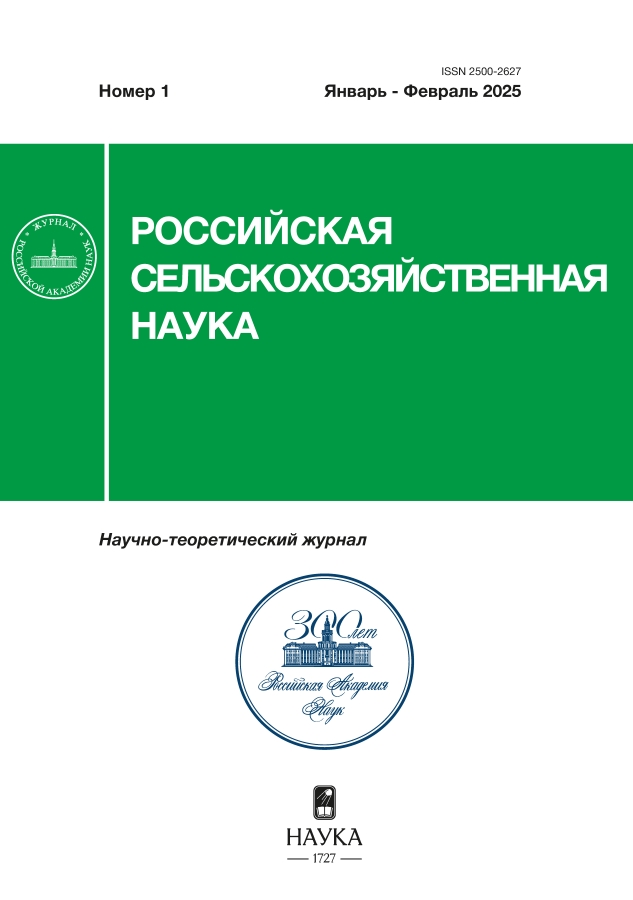Quality and contamination of lawn mixtures in the forest-steppe of the Middle Volga Region
- Авторлар: Timoshkin O.A.1, Timoshkina O.Y.1
-
Мекемелер:
- Federal Scientific Center of Bast-Fiber Crops Breeding
- Шығарылым: № 1 (2025)
- Беттер: 38-44
- Бөлім: Crop production, plant protection and biotechnology
- URL: https://journal-vniispk.ru/2500-2627/article/view/292015
- DOI: https://doi.org/10.31857/S2500262725010075
- EDN: https://elibrary.ru/CSNAHG
- ID: 292015
Дәйексөз келтіру
Аннотация
The aim of the study was to identify the effect of components (factor A) and their seeding rates in mixtures (factor B), the level of mineral nutrition (factor C) in the formation of lawn mixtures on weed infestation and their quality over the years of grass stand use in order to recommend the most effective of them for production. The experimental design included the following options: factor A – creeping clover + meadow bluegrass, creeping clover + perennial ryegrass, creeping clover + meadow fescue; factor B – 70 + 40 %, 55 + 55 %, 40 + 70 %; factor C – control (without fertilizers); P45K45; N30P45K45. In the forest-steppe of the Middle Volga region, two experiments (in 2019 and 2020) were conducted on leached chernozem and a study of grass mixtures for 3 years of use (2020–2023). The lawn mixtures were mowed 4…5 times per season when they reached a height of 10…12 cm. In terms of weed infestation, the mixtures were rated at 1 point (slightly weedy) in the first and second years of use and 2 points (moderately weedy) in the third year. By the third year of use, the lowest number of annual weeds was noted in mixtures of creeping clover with meadow bluegrass – 10.1…19.0 pcs/m2. With an increase in the fertilizer dose, the number of weeds decreased compared to the control – 10.1…22.8 pcs/m2, in the control variants – 10.5–26.4 pcs/m2. In the first year of using mixtures of creeping clover with meadow bluegrass and meadow fescue, the quality of the lawns was rated as «excellent». In the second year, fescue mixtures showed «good» and «excellent» ratings, while bluegrass and ryegrass mixtures mostly received «good» ratings, with some «satisfactory» variants. In the third year, clover-bluegrass mixtures showed the best characteristics: excellent density (6 points), high projective cover (5 points), complex rating – 30 points, which corresponds to the highest quality level.
Негізгі сөздер
Толық мәтін
Авторлар туралы
O. Timoshkin
Federal Scientific Center of Bast-Fiber Crops Breeding
Хат алмасуға жауапты Автор.
Email: o.timoshkin.pnz@fnclk.ru
доктор сельскохозяйственных наук
Ресей, 17/56, Komsomolsky Ave., Tver, 170041O. Timoshkina
Federal Scientific Center of Bast-Fiber Crops Breeding
Email: o.timoshkin.pnz@fnclk.ru
кандидат сельскохозяйственных наук
Ресей, 17/56, Komsomolsky Ave., Tver, 170041Әдебиет тізімі
- Сайдяшева Г. В., Захаров С. А. Результаты мониторинга содержания тяжелых металлов в почве, растениях и снежном покрове вблизи автомобильных трасс на различном удалении от города Ульяновска // Вестник Казанского государственного аграрного университета. 2022. Т. 17. № 4(68). С. 45–49.
- Сергатенко С. Н., Федорова И. Л., Игнатова Т. Д. Влияние нефтяного загрязнения на активность почвенных ферментов классов оксидоредуктаз и гидролаз // Вестник Ульяновской государственной сельскохозяйственной академии. 2022. № 3(59). С. 83–88.
- Газоны: устойчивость, долголетие, декоративность: монография / Н. Н. Лазарев, З. М. Уразбахтин, В. В. Соколова и да. М.: Изд-во РГАУ-МСХА им. К. А. Тимирязева, 2016. 163 с.
- Jeremy M., Masonb M., Ambrusa A. Urban greenspace is associated with reduced psychological stress among adolescents: A Geographic Ecological Momentary Assessment (GEMA) analysis of activity space // Landscape and Urban Planning. 2018. Vol. 174. P. 1–9. URL: https://www.sciencedirect.com/science/article/abs/pii/S0169204618300574 (дата обращения: 19.12.2024). doi: 10.1016/j.landurbplan.2018.02.008.
- To mow or to mow less: Lawn mowing frequency affects bee abundance and diversity in suburban yards / S. B. Lerman, A. R. Contosta, J. Milam, et al. // Biological Conservation. 2018. Vol. 221. P. 160–174. URL: https://www.sciencedirect.com/science/article/abs/pii/S0006320717306201 (дата обращения: 19.12.2024). doi: 10.1016/j.biocon.2018.01.025.
- Зубарев Ю. Н., Субботина Я. В., Вяткина И. П Формирование и оценка качества газонного покрытия откоса автодороги в Предуралье // Пермский аграрный вестник. 2017. № 2(18). С. 17–22.
- Костенко С. И., Седова Е. Г., Думачева Е. В. Селекция кормовых культур – основа устойчивого кормопроизводства на современном этапе развития России // Достижения науки и техники АПК. 2022. Т. 36. № 4. С. 15–21.
- Зубарев Ю. Н., Субботина Я. В., Вяткин А. В. Эксплуатационная характеристика газонных фитоценозов из злаковых трав отечественной селекции // Пермский аграрный вестник. 2017. № 3(19). С. 65–70.
- Зуева Г. А. Биоморфологические особенности овсяницы луговой при использовании в газонной культуре // Сибирский вестник сельскохозяйственной науки. 2009. № 5. С. 38–44.
- The impacts of different management practices on botanical composition, quality, colour and growth of urban lawns / P. Knot, F. Hrabe, S. Hejduk, et al. // Urban Forestry & Urban Greening. 2017. № 26. P. 178–183. URL: https://www.sciencedirect.com/science/article/abs/pii/S1618866716302370 (дата обращения: 19.12.2024). doi: 10.1016/j.ufug.2017.01.011
- Доусон Р. Б. Создание и содержание газона /пер. с англ. Б. Я. Сигалова. М: Наука, 1957. 296 с.
- Биолого-экологические особенности низовых злаковых трав и их использование при создании газонов / Н. Н. Лазарев, М. А. Гусев, О. В. Кухаренкова и др. // Кормопроизводство. 2020. № 1. С. 10–16. doi: 10.25685/KRM.2020.2020.56911.
- Гречушкина-Сухорукова Л. А. Ассортимент газонных трав и состояние газонов в объектах озеленения г. Ставрополя // Известия Тимирязевской сельскохозяйственной академии. 2022. № 1. С. 12–26. doi: 10.26897/0021-342X-2022-1-12-26.
- Доспехов Б. А. Методика полевого опыта с основами статистической обработки результатов. М.: Агропромиздат, 1985. 351 с.
- Методические указания по проведению полевых опытов с кормовыми культурами / под ред. Новоселова Ю. К., Харькова Г. Д., Шеховцова Н. С. и др. М.: ВИК, 1987. 198 с.
- Раменский Л. Г. Избранные работы. Проблемы и методы изучения растительного покрова. Л.: Наука, 1971. 335 с.
- Кобозев И. В., Латифов Н. Л., Уразбахтин З. М. Проведение полевых опытов по формированию газонов и оценка их качества. М.: Изд-во МСХА, 2002. 84 с.
- Субботина Я. В., Зубарев Ю. Н. Газоны в Пермском крае. Пермь: Изд-во ФГОУ ВПО «Пермская ГСА», 2010. 87 с.
- Баздырев Г. И. Защита сельскохозяйственных культур от сорных растений. М.: КолосС, 2004. 328 с.
- Опытное дело в полеводстве / сосТ. Никитенко Г. Ф. М.: Россельхозиздат, 1982. 190 с.
Қосымша файлдар









